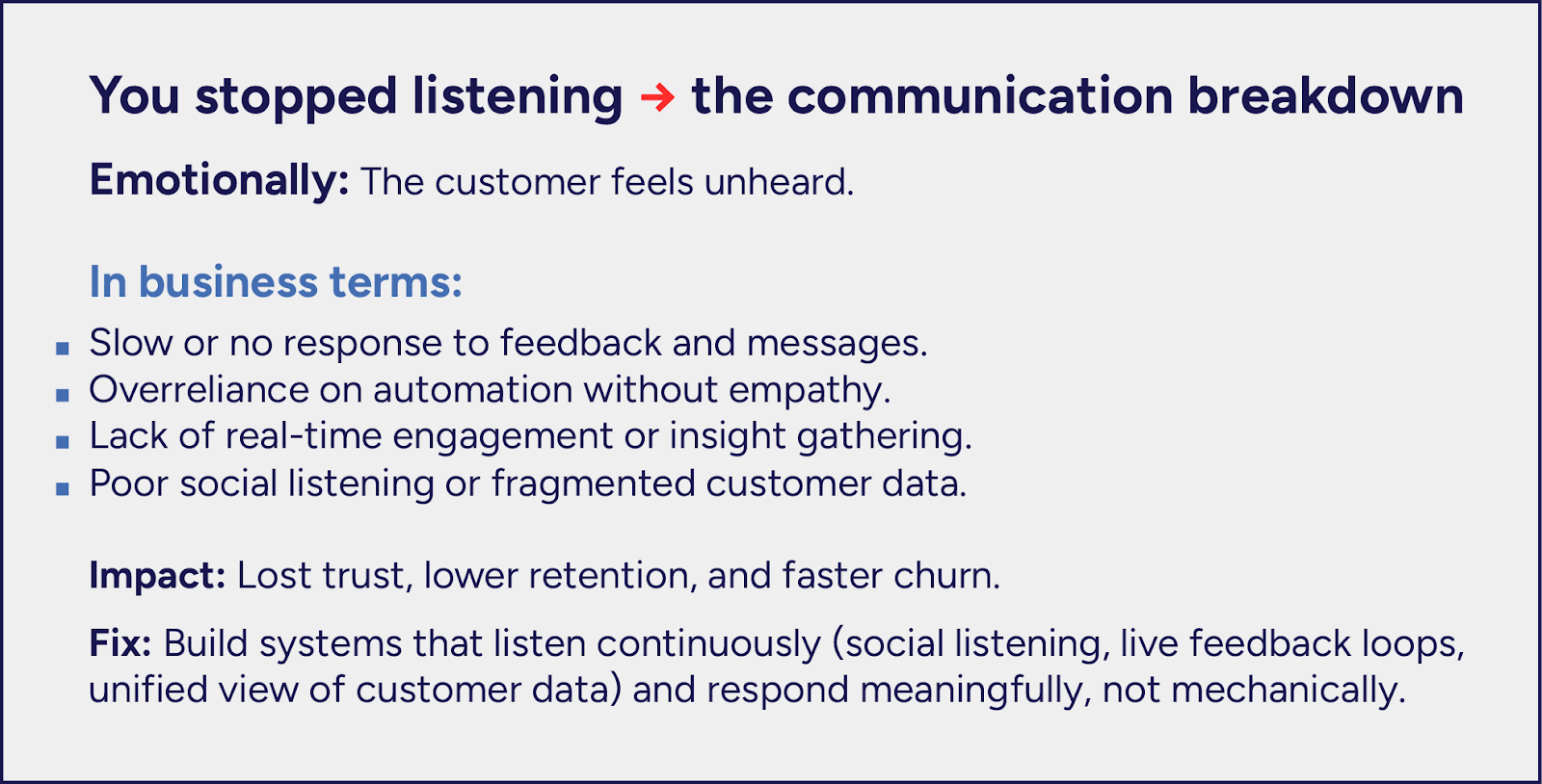Three silent killers hiding in your CX and what to do about them
I love you, you know that.
But you left me on read.
No reply, no reaction. Just silence.
How am I supposed to know if you never show me?
The tension fills the room. One side is frustrated. The other is defensive. Both insist they care, yet neither feels heard.
Welcome, everyone, to one of your many sessions of Brand and customer counseling.
I’ll be your therapist for today.
We’re here to talk about what went wrong. No, not the marketing strategy, not the campaign budget, but the relationship itself. Somewhere between the first click and the last conversion, the spark disappeared. Messages stopped feeling personal. Promises started feeling scripted. The connection broke down quietly.
Therapist: Alright, everyone, let’s take a seat.
Before we begin, I want you both to understand something. Relationships rarely fall apart in one dramatic moment. They unravel quietly, through patterns we ignore, signs we downplay, and words we stop saying.
That’s exactly what’s been happening here.
What looks like a drop in engagement or conversion is really a loss of connection.
So today, we’re going to unpack what went wrong, name the three habits that slowly pushed you apart, and talk about how to rebuild the bond before it’s too late.
Let’s start with the first one.
Silent killer #1: You stopped listening
Therapist: Tell me, when did you first feel unheard?
Customer: It started small. I used to send messages, leave feedback, and tag them in posts. At first, they’d reply. Then one day, nothing. No response, no acknowledgement. Just silence.
Brand: That’s not true. We listen. We have a whole system for that. We track reviews, comments, survey results, everything.
Therapist: That’s not listening. That’s collecting.
Listening is not about gathering information. It is about making people feel seen. It is about hearing what they mean, not just what they say.
Somewhere along the way, brands began to mistake feedback for a statistic, a number on a dashboard rather than a bridge to understanding. But feedback is not noise. It is direction. It tells you exactly where the relationship is hurting and where it can grow.
And we have talked about this before in our past session: Why feedback is your fastest growth level. Remember? We discussed why a customer who feels ignored rarely complains twice. They just drift away.
According to PwC, more than half of consumers say they’ll switch brands after a single bad experience. They won’t always tell you why. They’ll simply move on to someone who listens better.
Listening is the foundation of trust. When customers reach out, they’re not always asking for answers. Sometimes, they just want to know someone’s on the other side.
Brands that listen deeply don’t just collect insights. They build relationships. They spot the small cracks before they turn into exits. They respond faster, act smarter, and communicate like humans, not headlines.
Therapist: So, what have we learned here?
Brand: That listening isn’t about data. It’s about presence. About making people feel heard, not managed.
Customer: Exactly. I never needed perfection. I just needed proof that you were listening.
Simply put,

Silent killer #2: You took them for granted
Therapist: Let’s talk about effort. When did you last do something special for each other?
Customer: It’s been a while. In the beginning, they cared about every detail. The emails felt personal. The replies were quick. The experience felt made for me. Now it’s all templates and automated messages. The energy is gone.
Brand: We still deliver. The product is great, the campaigns run smoothly, and everything works.
Therapist: Working isn’t the same as caring.
That’s what happens when relationships grow comfortable. You stop doing the small things that once kept the spark alive. You assume the other person will stay because they always have.
Brands do it too. After acquisition, the chase ends. The customer becomes a number in a dashboard. The focus shifts to the next lead, the next campaign, the next big thing. Meanwhile, the people who already trusted you start to feel forgotten.
According to research by Invesp, acquiring a new customer can cost up to five times more than retaining an existing one. Yet most teams still invest more in attraction than in appreciation. The irony is painful: you lose what you already had while chasing what you don’t.
Real loyalty is not built on efficiency. It’s built on emotion. Appreciation. Gratitude. A thank-you message that doesn’t sound automated. A follow-up that shows care. A gesture that says “we noticed you,” not “you’re next in queue.”
Customer: I never needed grand gestures. I just wanted to feel valued again.
Brand: Then I’ll start showing it. Not because I have to, but because I want to keep you.
Relationships don’t last because of history. They last because someone keeps choosing to show up.
In other words,

Silent killer #3: You stopped surprising them
Therapist: You said earlier that you still care about each other. So why does it feel like you’re growing apart?
Customer: Because it’s all the same now. The same tone, the same offers, the same experience. I already know what’s coming next. There’s no spark, no curiosity, no reason to stay excited.
Brand: But we’ve been consistent. Isn’t that what people want?
Therapist: Consistency builds trust. Curiosity keeps it alive.
That’s where many relationships, and brands, lose their magic. They stop evolving. The product still works, the service still delivers, but the feeling fades. There’s no anticipation, no emotion, no moment that reminds the customer why they fell in love in the first place.
The truth is, people don’t fall out of love overnight. They fall out of interest.
In business, that looks like repetitive campaigns, predictable emails, outdated UX, and messaging that never changes tone. Customers can sense when a brand stops experimenting. When the experience feels static, loyalty turns into habit, and habits are easy to replace.
McKinsey’s research shows that seventy-one percent of consumers expect personalization, and three-quarters feel frustrated when they don’t get it. But personalization alone isn’t enough anymore. People crave freshness. They want brands that adapt, evolve, and make them feel seen in new ways.
Innovation in CX doesn’t have to mean radical technology. Sometimes, it’s a human gesture: a new story, a different tone, a bold campaign that makes people look twice. Brands that surprise remind customers that they’re alive, that they still have ideas, personality, and purpose.
Therapist: Relationships last when both sides keep growing. You can’t stay interesting if you stop being curious about each other.
Brand: So, I need to keep evolving. Not for attention, but to keep the connection real.
Customer: Exactly. Keep me guessing. Keep me inspired. Keep me feeling something.
Because loyalty isn’t built on routine. It’s built on renewal.
Or to say it another way,

The breakthrough
The session is almost over.
The customer leans back, calmer now. The brand looks thoughtful for the first time in a while. Between them, the silence that once felt heavy now feels different. Not empty, but honest.
They both know the truth. It was never really about the campaigns or the conversions. It was about attention. About effort. About keeping the spark alive long after the first impression fades.
Therapist: So, what did we learn today?
That listening keeps the dialogue alive.
That appreciation keeps loyalty breathing.
And that surprise keeps curiosity awake.
That is how relationships survive, in life and in business.
Growth isn’t just a funnel. It’s also a feeling. One built slowly through moments that prove you care enough to listen, to notice, to adapt.
Because when brands treat customers like people, not metrics, something powerful happens. The charts start to rise, yes, but more importantly, the connection becomes real again.
Therapist: I think we made progress today. You both did well. Let’s pick this up in our next session.


.svg)







.svg)




.svg)





.svg)